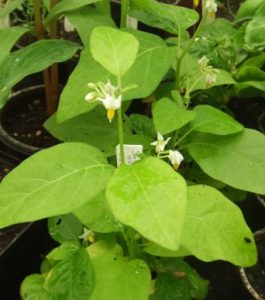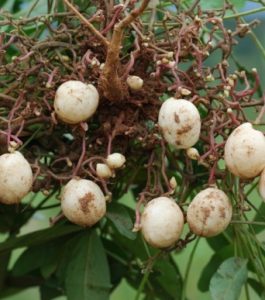 Common Name: Mungbean
Common Name: Mungbean
Description
The mung bean (Vigna radiata), alternatively known as the moong bean, green gram, is a plant species in the legume family. The mung bean is mainly cultivated in India, China, and Southeast Asia. It is used as an ingredient in both savory and sweet dishes. . . . .Read more
References
Switchboard
Wikipedia
Annuals
Solanum aethiopicum
 Common Name: African Eggplant
Common Name: African Eggplant
Description
Solanum aethiopicum, the bitter tomato, Ethiopian eggplant , or nakati, is a fruiting plant of the genus Solanum mainly found in Asia and Tropical Africa. It is also known as Ethiopian nightshade, garden eggs, and mock tomato. It is a popular vegetable in north-east India, and is known as khamen akhaba in Manipuri and samtawk in Mizo. These names are a result of its varied morphology, with ripe fruit often looking like a cross between an eggplant and a tomato, which are also from Solanum. In fact, the Ethiopian eggplant was so much confused with the ordinary eggplant that t . . . . .Read more
References
Switchboard
Wikipedia
Lablab purpureus
 Common Name: Lab lab Bean
Common Name: Lab lab Bean
Description
Lablab purpureus is a species of bean in the family Fabaceae. It is native to Africa and it is cultivated throughout the tropics for food. English language common names include hyacinthbean, lablab-bean bonavist bean/pea, dolichos bean, seim bean, lablab bean, Egyptian kidney bean, Indian bean, bataw and Australian pea. It is the only species in the monotyp. . . . .Read more
References
Switchboard
Wikipedia
Vigna subterranea
 Common Name: Bambara groundnut
Common Name: Bambara groundnut
Description
Vigna subterranea (also known by its common names Bambara groundnut, Bambara-bean, Congo goober, earth pea, ground-bean, or hog-peanut) is a member of the family Fabaceae. The plant originated in West Africa. Vigna subterranea ripens its pods underground, much like the peanut (also called a groundnut). They can be eaten fresh or boiled after drying. . . . .Read more
References
Switchboard
Wikipedia